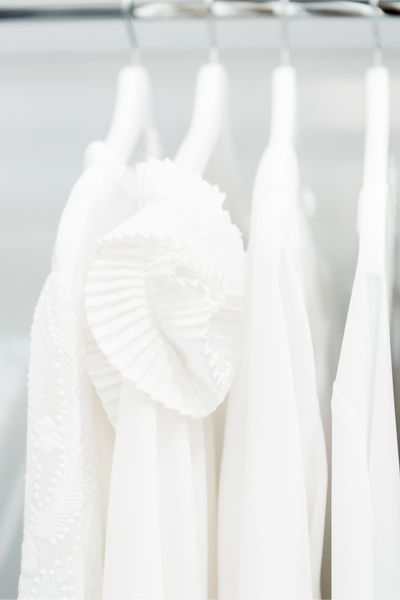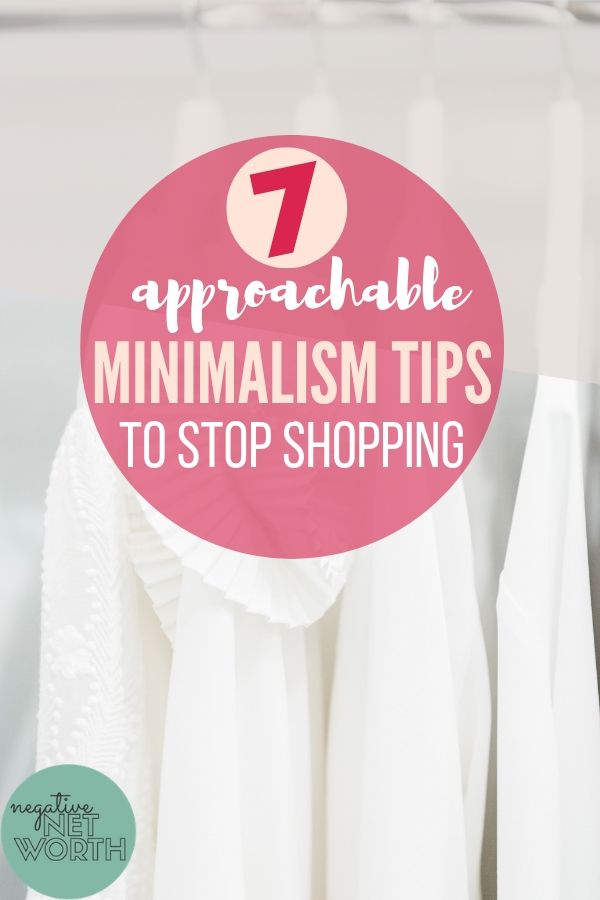
Easy Minimalism Strategies to Stop Shopping
I don’t consider myself a minimalist, in the strict sense of the term. But I love using minimalism strategies to approach my slightly-more-maximalist life—and to stop shopping.
The truth is, I am constantly inspired by the minimalist way of life, not only because I find it aesthetically pleasing, but also because it’s intentional.

I realize there is no one-size-fits-all approach to minimalism. In fact, minimalism is often a matter of personal preference, especially when it comes down to shedding excess and holding onto what is truly important to you.
Plus, when you live in a one-bedroom apartment with your husband and two cats like I do, you necessarily have to live with less to avoid clutter and clear your mind. 🙂
So while I haven’t fully taken the plunge into minimalism, in the meantime, I’ve picked up some very useful minimalism tips and applied them to my own spending habits. (If you are looking for a gentle introduction to minimalism, check out The Minimalists and Joshua Becker.)
And by the way? Grab a copy of my FREE Minimalist Shopping Checklist here to jumpstart your progress.
Not sure you have minimalism in you?
Now, I know what you might be thinking. For spendthrifts especially, the idea of minimalism is completely horrifying. How can I, a person who loves to buy STUFF, embrace minimalism? I hear you.
But this post isn’t about throwing out all your things. Far from it. Instead, think of this post as a pit stop along the way to more informed consumerism in your own life, and thus to less shopping. It might not be “true” minimalism, but it’s something. And every bit helps!
simple Minimalist Shopping Strategies
So with that, here are 7 approachable minimalism strategies to help you stop shopping.
1. Only buy things that are in line with your ethics, values, and beliefs.
Take a few minutes and jot down what you value most. Is it family? Social justice? Faith? All or none of the above? Whatever your ethics, values, and beliefs are, an easy way to live with less is to only buy things that align with your values.
For instance, if you value sustainability, you can make it a point to only purchase new items from companies that promote sustainability or use recycled materials. And if you value animal welfare, you might only purchase new makeup or skincare from companies that do not test on animals.
Once you do that, it becomes a lot easier to live minimally. By consuming only what aligns with your own moral code, you necessarily will buy less.
2. Do not buy anything that does not add value to your life.
Slightly different from the “values” mentioned above, this minimalist shopping tip speaks to an item’s usefulness. An item is useful if it: helps you with something tangible, makes your life easier, or brings you joy.
You have to be careful and discerning here. It’s easy for a shopaholic to say that ANY new handbag would make her happy. That is not what I mean!
This minimalism strategy forces you to get real with yourself. Will this new item really add value to your life? Or are you just convincing yourself to consume?
3. If you already own it, do not buy more.
This one is pretty simple, and yet, shopaholics struggle with it. I used to!
I often see this with makeup and clothing. For instance, lots of makeup addicts buy “backups” of their favorite products (foundation, eyeshadow, etc.). This especially becomes an issue with “limited-edition” items; all the consumerist synapses in the brain fire up at the thought of missing out on more of what you “love.”
Listen: it’s a trap. It will become so easy for you to employ this minimalist shopping strategy by taking stock of what you already own, appreciating it, and understanding that you do not need to own more of what you enjoy in order to be happy. I promise!
4. If you don’t have space for it, do not buy it.
Minimalists have the right idea! Personally, I hate clutter, and yet…what’s the first thing that happens when we over-shop? We end up with a bunch of crap we don’t have room for!
Just like your time and money is a resource, the space in your home is a resource. When we shop for new things, we are wasting multiple resources, and storage is one of them.
Thus, by utilizing this minimalist shopping strategy, you can cut down on future purchases.
5. If it’s going to make you go into debt, do not buy it.
This is so important. Seriously. Consumer debt is evil and I’m begging you to not fall into that trap.
One thing I love about minimalism is its insistence that you not acquire debt. It makes perfect sense: when you live with only the essentials, you don’t need to expend resources you don’t possess in order to acquire more. So if you can’t afford it, the decision is already made for you: you can’t shop.
But the other thing about minimalism? It’s about freedom. Freedom from stuff and freedom from chains. And Americans are utterly chained down by debt. Why make your financial condition worse in the name of the next new thing?
This minimalist shopping strategy, which is really just good financial sense, will keep your head on straight the next time you pull out your credit card to purchase something outside your budget.

6. Do not buy it if it overwhelms you or saps your energy.
Have you thought about the time you spend on shopping? From going to the store to researching sales to scrolling through Amazon, spendthrifts overwhelm themselves with decision fatigue.
What do I buy? What color? Can I get a discount code? When will they restock this? How will I live without this!?
You get the idea. I’m sure you’ve been there yourself! Minimalism is about reducing overwhelm in your everyday life. This goes for physical stuff, sure, but it’s also a mental game.
Minimalists value being at peace. Thus, if the process of purchasing something new is overwhelming you mentally, making you anxious, or draining your energy, stop. End the transaction right there.
7. If it is not a deliberate purchase, do not complete the transaction.
Last, but not least: minimalists live deliberate lives. It’s kind of the whole point! And one thing they DON’T do? Impulse shop.
Why is that? Well, impulse-shopping is not a decision that is meaningful or purpose-driven. It’s simply giving in to our most base desires, our reptilian brain, which tells us to consume. Aka: shop and spend money on stuff we don’t need!
By adopting a more deliberate approach to your everyday life, like a minimalist, you may find your impulses to buy new things diminishing.
Conclusion
I hope these 7 approachable minimalist shopping tips will help you the next time you feel the urge to spend. By using these minimalism strategies regularly, you will start to notice a huge improvement in your impulse-control—and your finances!
And don’t forget to grab a copy of my FREE Minimalist Shopping Checklist here!

want to remember this post? pin it for later!


Leave a Reply